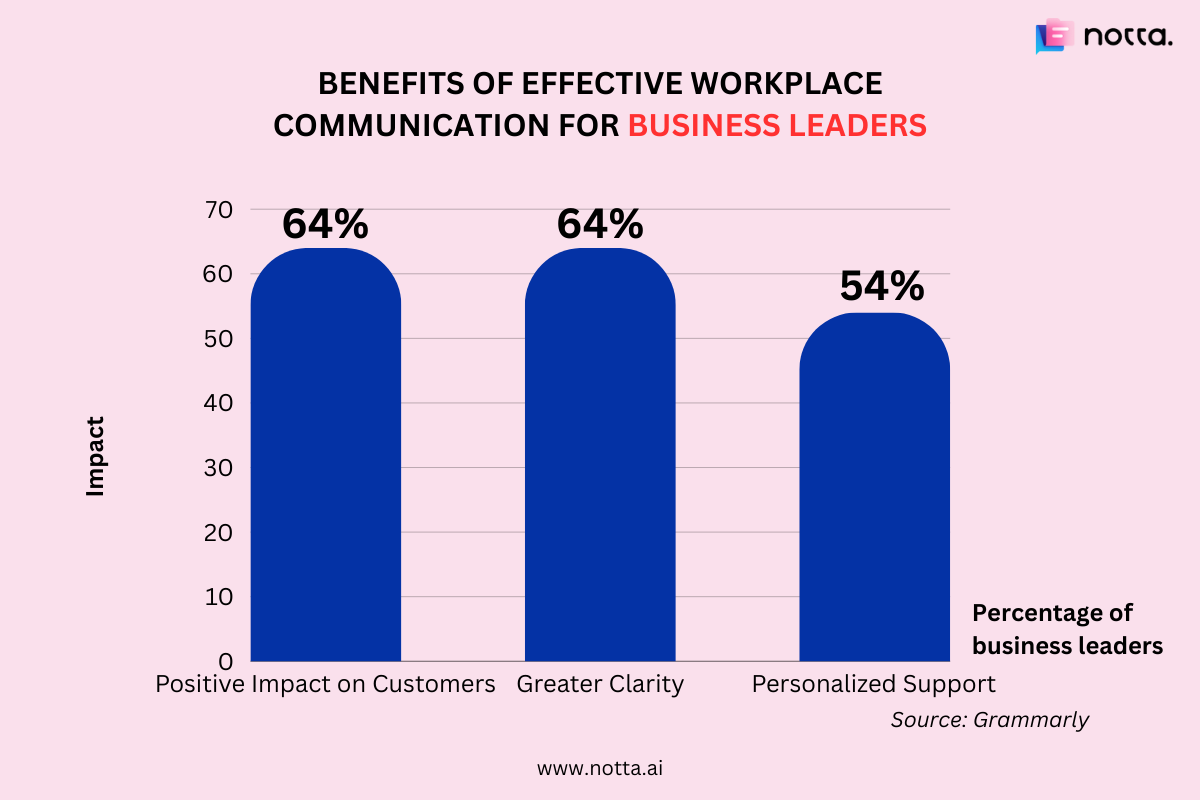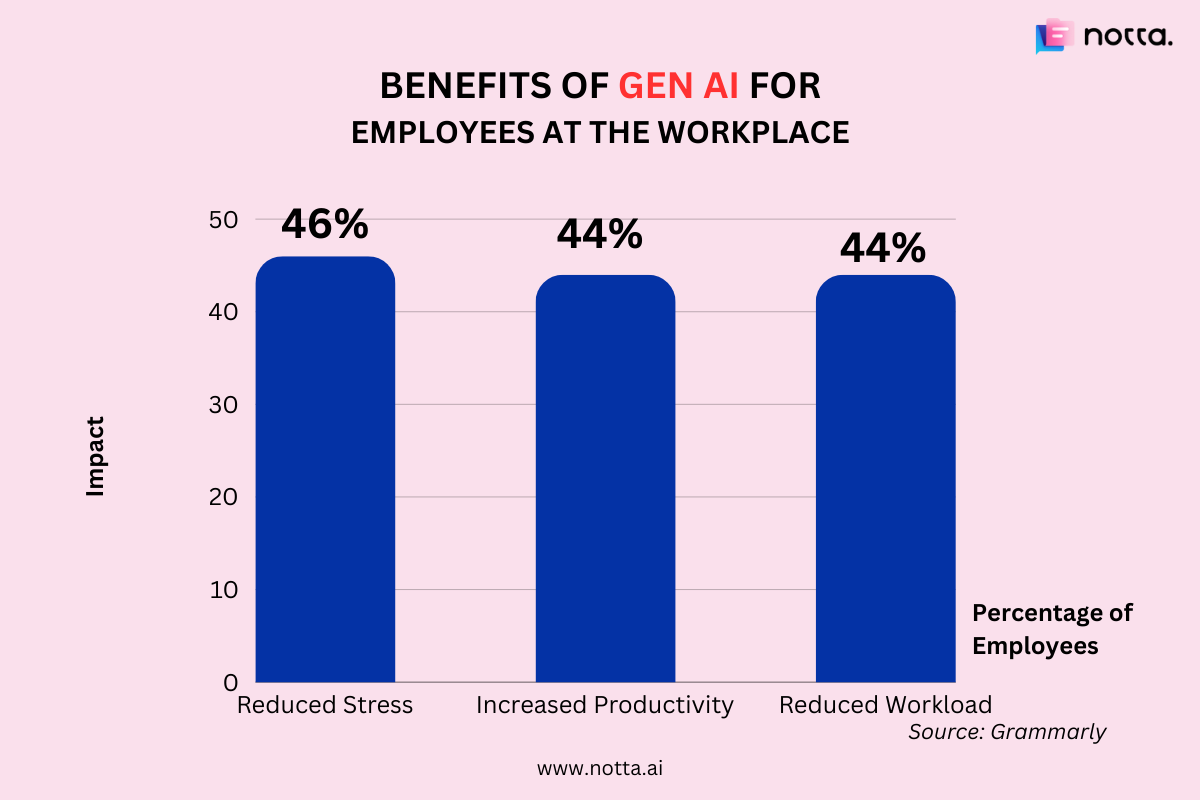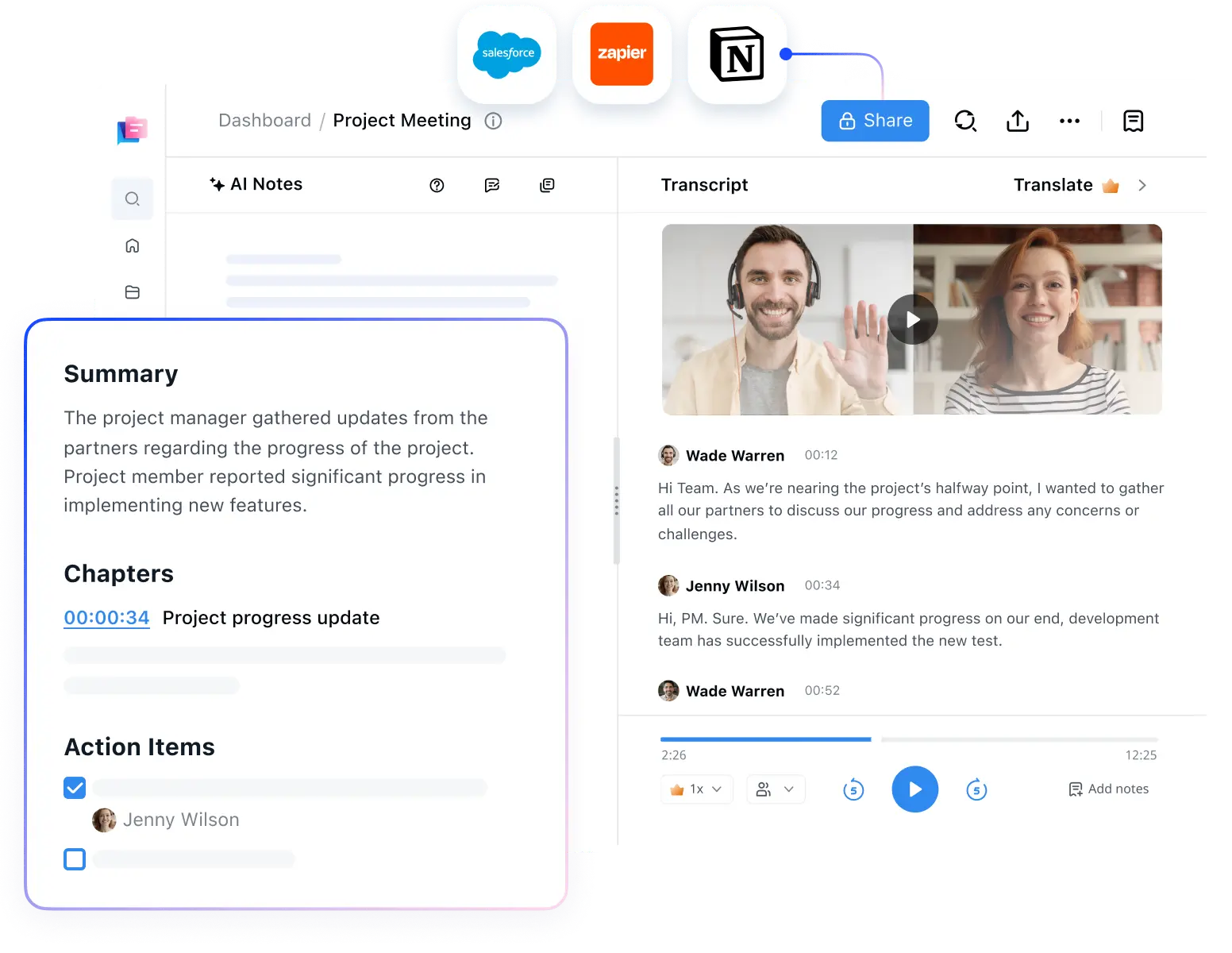
60+ Must-know Workplace Communication Statistics in 2025
Record, transcribe and summarize conversations with one click.
With the dynamics of working environments changing, particularly after the COVID-19 pandemic, the nature of workplace communication has also witnessed a major shift. Navigating these changing tides is crucial for any organization that wants to stay ahead of the competition.
In this guide, I list more than 60 communication in the workplace statistics you must know so you can make informed decisions about how your organization functions. They’re categorized into different sections to make them easier to understand.
Importance of workplace communication
Workplace communication is about more than just conversations. They drive engagement and collaboration and ensure information is seamlessly shared across channels. Here are a few reasons why effective workplace communication is critical:
Helps make informed decisions: Effective communication ensures employees at all levels have the information they need to make sound decisions.
Boosts employee engagement: Better communication at the workplace helps keep employees engaged, incentivizing them to do better every day.
Improves collaboration: Without the use of the right communication channels and strategies, collaboration between teams and individuals would be impossible.
Short summaries of workplace communication
This section offers a summary of the key workplace communication statistics and findings about workplace communication.
55% of people communicate with their clients via email in 2024.
Effective communication leads to a 72% increase in productivity among business leaders.
42% of workers stated that poor communication affected cross-functional collaboration.
82% of knowledge workers and 90% of business leaders state that working remotely increases their need to be a better communicator.
62% of people work and communicate directly with teammates across multiple time zones.
A study stated that nonverbal communication accounts for 93% of the impact of any given message.
21% of workers claim that remote work made communication somewhat difficult, and 6% found that it made communication very difficult.
General workplace communication statistics
In this first section of workplace communication statistics, we dive into some general numbers you must know to have an overview of the state of workplace communication.
55% of people communicate with their clients via email in 2024.
About 11% use online chat tools like Slack, whereas another 11% use project management tools.
73% of businesses use or plan to use AI-powered chatbots for instant communication.
61% of companies use AI to optimize emails and make communication quicker and more seamless.
Businesses use AI to generate long-form content in the form of website copy at 42%, and for personalized advertising at 46%.
31% of employees stated that they use email to communicate with their colleagues internally.
The hidden costs of poor communication in US businesses add up to a whopping $1.2 trillion or $12,506 per employee per year.
Effective communication leads to a 72% increase in productivity among business leaders.
Effectively managed communication also leads to a 56% increase in work satisfaction among knowledge workers.
Communicating with others took up 72% of the entire workweek in 2023, two hours more than the amount of time it took up in 2022. This is a direct result of an increase in asynchronous video communication and via other means.
As a result of an increase in remote and hybrid work after the COVID-19 pandemic, a staggering 74% of businesses have started using a new tool to help organize, communicate, and manage their projects over a period of 12 months.
61% of customer service professionals report feeling increasingly confident at work as a result of effective communication.
Trends in workplace communication have witnessed significant changes since the onset of the COVID-19 pandemic. From in-person meetings and discussions, communication largely shifted online, relying mainly on tools like email, video conferencing platforms like Zoom and Microsoft Teams, and team chat tools.
Poor communication in the workplace statistics
Poor communication has direct consequences on various aspects of an organization, from its bottom line to customer satisfaction and employee engagement and retention.
According to Grammarly’s 2024 State of Business Communication report, the cost of miscommunication at the workplace cost US businesses $1.2 trillion in 2022. 2023 was a rise in communication, while its effectiveness simultaneously declined. In 2024, however, AI has brought about new solutions and challenges that have forced businesses to focus on better and not more communication.
Here are a few statistics on poor communication in the workplace:
With an increase in remote and hybrid work, businesses are increasingly relying on written communication, with an 18% increase year over year.
66% of business leaders experience some form of miscommunication at least once a day.
48% of business leaders experience miscommunication at the workplace multiple times a day.
100% of business leaders and knowledge workers stated experiencing miscommunication at the workplace at least once a week.
The increasing use of digital communication tools has led to a blurring of the lines between one’s work hours and their personal life. 60% of workers stated that digital communication has led to burnout. In comparison, hybrid and on-site workers are slightly less likely to experience burnout as a result of digital communication at 56% and 49% respectively.
Only 11% of workers report that ineffective communication has no effect on them.
50% of workers reported that ineffective or poor communication impacted their job satisfaction. 42% stated that it affected their stress levels.
Over 40% of workers reported feeling that poor communication affects trust in their leadership and team.
42% of workers stated that poor communication affected cross-functional collaboration.
29% of workers say that miscommunication as a result of an asynchronous setup strains their relationship with their colleagues.
15% of workers state that miscommunication has also led them to consider changing their teams.
22% of workers state that miscommunication has led them to consider finding a new job.
Effective communication statistics
Effective communication is the backbone of the success of any organization. Without it, most processes crumble, and the overall revenue takes a hit. This section illustrated some key statistics that highlight the importance of effective communication.
Tools and technologies
Listening to employees is crucial to ensure seamless communication and that organizations make improvements where necessary. 75% of communicators reported using engagement surveys to gather qualitative feedback, whereas 54% use post-event feedback, and 52% use live Q&A sessions.
68% of communicators believe that AI will have a major impact on the workplace in the next 5 years, which is an increase from the 40% recorded during Gallagher’s previous State of the Sector 2022/2023 survey.
78% of knowledge workers state that asynchronous communication is beneficial, with 42% saying it increased their productivity and 34% feeling a greater sense of inclusion.
73% of professionals have seen an increase in the variety of channels used to communicate at the workplace. While the use of different tools and channels can be effective, it also points to an increase in the overall workload despite the availability of such technology.
The use of gen AI for communication could save up to $1.6 trillion in US productivity, but its potential remains to be fully tapped into.
57% of business leaders are optimistic about investing in modern communication strategies and prioritizing operational efficiency, 55% prioritize margins, and 54% prioritize employee satisfaction and retention.
60% of all professionals use gen AI for work. Additionally, 56% of knowledge workers say they can’t imagine doing their work tasks without gen AI.
Best practices
64% of business leaders state that effective communication has had a positive impact on their customers in terms of timely support, 64% cite greater clarity, and 54% say that it leads to personalized support.

46% of employees say that the use of gen AI has led to reduced stress, 44% cite the benefit of increased productivity, and 44% state that it has reduced their workload.

It’s essential to tailor support and training for AI based on the employees’ roles. 68% of knowledge workers state that generative AI can help them communicate more effectively at work.
There are several companies that have successfully leveraged effective channels and methods for communication. Google, for example, has been known for leveraging multiple internal communication channels, including Google+, Hangouts, and Google Groups.
HubSpot is another company that utilizes tools such as Google Drive, Slack, and Zoom to successfully streamline internal communication.
Preferred communication method statistics
With time and the changes brought about by the COVID-19 pandemic, preferred communication methods across knowledge workers and business leaders have seen a major change. This section lists some key statistics that help paint a picture of the preferred communication methods.
Email remains the most popular tool for communication, with 18% of knowledge workers marking it as their preference.
Video calls are the second most popular choice for workplace communication, with 17% marking their preference for it.
40% of respondents to the Forbes Advisor survey who are between the ages of 59 and 77 stated their preference for in-person conversations.
Among those between the ages of 18 and 26, the preference for in-person conversations fell to 17%, whereas it reduced to 16% for those between 27 and 42 years of age.
When the choice comes to audio calls, 16% of remote workers stated their preference for it, whereas the number marginally decreased to 15% for hybrid workers and 9% for on-site workers.
14% of workers stated they preferred direct messages, whereas the number increased to 16% for hybrid workers and 11% for on-site workers.
The preference for text messages stood at 19% for on-site workers, 14% for remote workers, and 11% for hybrid workers.
82% of knowledge workers and 90% of business leaders state that working remotely increases their need to be a better communicator.
Remote workplace communication statistics
Remote work has made a noticeable impact on workplace communications. While the initial shift threw up multiple challenges, organizations soon adapted by increasingly using digital communication or project management tools to streamline their workflows. The statistics below demonstrate how they influence communication in the workplace.
Given a rise in remote and hybrid work after the pandemic, the top challenges associated with disconnection at the workplace include disconnected data and systems, difficulties with internal communication and collaboration, and trouble engaging with prospective buyers.
84% of business leaders are using asynchronous communication methods, while the percentage for knowledge workers stands at 72%.
49% of millennials say that they can achieve more with asynchronous communication.
To keep up with changing workplace dynamics and remain strategic, 37% of organizations stated they planned on implementing system and technology changes in 2024.
In terms of the use of different communication channels, face-to-face and web calls dominated, showing that real-time broadcasts were the most effective.
62% of people work and communicate directly with teammates across multiple time zones.
75% of remote workers spend anywhere between 1-10 hours of their workweek communicating in meetings. There’s also time spent emailing someone who missed a meeting.
62% of remote workers prefer being on camera during work meetings, equating to 38% who prefer being off camera.
50% of remote workers prefer using messaging apps when communicating with their clients or teams. This is followed by 22% who prefer using email and 19% who prefer meetings.
Communication in remote workplaces can make work easier or more challenging, depending on who you ask. Buffer’s survey found that 40% of the respondents found their work-life balance to be very healthy while they worked from home, whereas 2% stated it to be very unhealthy.
75% of remote workers stated that they feel connected to their colleagues despite working remotely.
81% of remote workers state that they check their emails outside of their work hours.
80% of business leaders can think of concrete examples of when unclear communication left them feeling anxious or stressed.
Nonverbal communication in the workplace statistics
With remote and hybrid work on the rise, nonverbal communication has become the norm across industries. The following statistics shine some light on its prevalence, benefits, and challenges.
A 2020 study found that 85% of the 150 people surveyed believed eye contact to be critical to business communication.
70% of respondents also stated that facial expressions like smiling also impacted business communication.
Only about 55% claimed to be able to accurately guess the emotions behind certain facial expressions.
25% of respondents agreed with the prompt that physical appearance influences business communication.
42% of respondents corroborated the finding that one of the leading causes of professional miscommunication was the use of different communication styles.
21% of workers claim that remote work made communication somewhat difficult, and 6% found that it made communication very difficult.
12% of workers stated that remote work made communication easier, whereas 7% stated that it made it much easier.
79% of business leaders stated that they find it difficult to discern tone when reading written communication, while the number stood at 76% for knowledge workers.
62% of all knowledge workers stated that they’re more likely to respond quickly if the message they receive has a positive tone.
48% of all knowledge workers stated that they were more likely to address concerns quickly or deliver higher quality output if they were communicated with in a positive tone.
Improve your workplace communication outcomes with Notta

Notta is an AI meeting note-taking tool that can significantly streamline your meetings and communication. You can use it to record, transcribe, translate, and summarize your meetings so every team member has a clear record of their action items. Notta offers several benefits, including:
Enhanced efficiency: Notta allows you to automate the note-taking process so you can organize your data effectively. It also allows you to streamline your communication as you can collaborate on the transcripts in real time.
Improved collaboration: Notta can help facilitate improved communication within and outside your team with its collaborative features.
Notta’s intuitive platform streamlines the entire meeting experience, making it the ideal tool for remote and on-site teams alike. It makes your meetings a lot more effective with its summarizing abilities and ensures greater accessibility for those across different linguistic backgrounds and time zones.
Experience how you can make your meetings more productive with Notta with its free trial!
Let Notta worry about the details so that you can focus on the meeting. Accurate, real-time meeting notes at your fingertips.
The bottom line
Effective communication is the cornerstone of any organization and can set the stage for improved performance across the board. While the change to remote and hybrid work after the COVID-19 pandemic has changed the organizational landscape globally, industries have been quick to adapt for the most part with a greater adoption of technology.
In this guide, I’ve listed 60+ communication in the workplace statistics that will help you understand the various aspects of workplace communication, their overall impact, and the various challenges and attitudes to it across employees at all levels and age groups. With these, you should be equipped to make informed decisions on how you can improve your workplace communication for the maximum benefit.
A tool like Notta, for example, can help you streamline your meetings, which are critical to an organization’s functioning. It can record, transcribe, translate, and summarize all your meetings so you have a clear record of what was discussed and can focus on the crux of the discussion rather than on note-taking.
References
Project.Co: Communication Statistics 2024
Project.Co: Communication Statistics 2023
Grammarly: The State of Business Communication: New Threats and Opportunities
Forbes Advisor: The State of Workplace Communication in 2024
McKinsey: The social economy: unlocking value and productivity through social technologies
HubSpot: Identifying and Overcoming the Crisis of Disconnection
Gallagher: State of the Sector 2023/2024
Sage Journals: Nonverbal Communication: An Essential Skill in the Workplace
Buffer: State of Remote Work 2023
Grammarly: 2024 State of Business Communication
Forbes Advisor: How Businesses are Using Artificial Intelligence in 2024